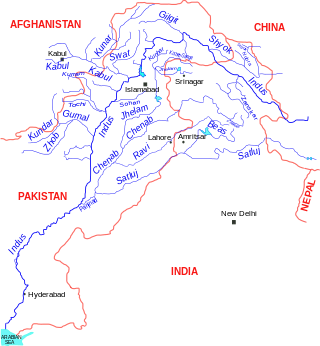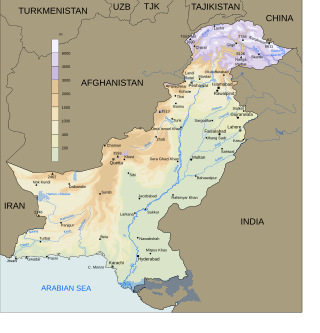Related Research Articles

The Indus is a transboundary river of Asia and a trans-Himalayan river of South and Central Asia. The 3,180 km (1,980 mi) river rises in mountain springs northeast of Mount Kailash in Western Tibet, flows northwest through the disputed region of Kashmir, bends sharply to the left after the Nanga Parbat massif, and flows south-by-southwest through Pakistan, before emptying into the Arabian Sea near the port city of Karachi.

The Ravi River is a transboundary river crossing northwestern India and eastern Pakistan. It is one of five rivers associated with the Punjab region.

The Sutlej River is the longest of the five rivers that flow through the historic crossroads region of Punjab in northern India and Pakistan. The Sutlej River is also known as Satadru. It is the easternmost tributary of the Indus River. The Bhakra Dam is built around the river Sutlej to provide irrigation and other facilities to the states of Punjab, Rajasthan and Haryana.

Sukkur Barrage is a barrage on the River Indus near the city of Sukkur in the Sindh province of Pakistan. The barrage was built during the British Raj from 1923 to 1932 and was named Lloyd Barrage. The Sukkur Barrage, is the pride of Pakistan's irrigation system as it is the largest single irrigation network of its kind in the world. It irrigates from Sukkur district in the north, to Mirpurkhas/Tharparkar and Hyderabad districts in the south of Sindh, almost all parts of the province. It is situated about 500 kilometres northeast of Karachi, 5 kilometres below the railway bridge, or the Sukkur Gorge. The introduction of barrage-controlled irrigation system resulted in more timely water supplies for the existing cultivated areas of Sindh province of Pakistan.

The Indus Water Treaty (IWT) is a water-distribution treaty between India and Pakistan, arranged and negotiated by the World Bank, to use the water available in the Indus River and its tributaries. It was signed in Karachi on 19 September 1960 by then Indian Prime Minister Jawaharlal Nehru and then Pakistani president Field Marshal Ayub Khan.

The Government of the Punjab is the provincial government of the Pakistani province of the Punjab. It is based in Lahore, the provincial capital. Its powers and structure are set out in the provisions of the Constitution, in which 41 districts come under its authority and jurisdiction. The government includes the cabinet, selected from members the Punjab Provincial Assembly, and the non-political civil staff within each department. The province is governed by a unicameral legislature with the head of government known as the Chief Minister. The Chief Minister, invariably the leader of a political party represented in the Assembly, selects members of the Cabinet. The Chief Minister and Cabinet are thus responsible for the functioning of government and are entitled to remain in office so long as it maintains the confidence of the elected Assembly. The head of the province is known as the Governor, appointed by the federal government, on behalf of the President. The administrative and executive boss of the province is the Chief Secretary Punjab and they head all the provincial departments and the provincial cabinet.

The Ministry of Railways is a ministry of the Government of Pakistan tasked with planning, administrating and overseeing government policies for the development of the national rail network, Pakistan Railways. Originally a department of the Ministry of Communications, in May 1974 it formed into an autonomous ministry of the federal government. The ministry headquarters is located at Block D of the Pak Secretariat in Islamabad.
Environmental issues in Pakistan include air pollution, water pollution, noise pollution, climate change, pesticide misuse, soil erosion, natural disasters, desertification and flooding. According to the 2020 edition of the environmental performance index (EPI) ranking released by Yale Center for Environmental Law & Policy, Pakistan ranks 142 with an EPI score of 33.1, an increase of 6.1 over a 10-year period. It ranked 180 in terms of air quality. The climatic changes and global warming are the most alarming issues risking millions of lives across the country. The major reasons of these environmental issues are carbon emissions, population explosion, and deforestation.
Rail transport in Pakistan began in 1855 during the British Raj, when several railway companies began laying track and operating in present-day Pakistan. The country's rail system has been nationalised as Pakistan Railways. The system was originally a patchwork of local rail lines operated by small private companies, including the Scinde, Punjab and Delhi Railways and the Indus Steam Flotilla. In 1870, the four companies were amalgamated as the Scinde, Punjab & Delhi Railway. Several other rail lines were built shortly thereafter, including the Sind–Sagar and Trans–Baluchistan Railways and the Sind–Pishin, Indus Valley, Punjab Northern and Kandahar State Railways. These six companies and the Scinde, Punjab & Delhi Railway merged to form the North Western State Railway in 1880. Following the independence of Pakistan in 1947, the North Western Railway became Pakistan Western Railway and the rail system was reorganised in the dominion of Pakistan; some of the reorganisation was controversial. Rail use increased in early 1948, and the network became profitable. Declining passenger numbers and financial losses in the late 1980s and early 1990s prompted the closure of many branch lines and small stations. The 1990s saw corporate mismanagement and severe cuts in rail subsidies. Due to falling passenger numbers, government subsidies are necessary to keep the railways financially viable.

Mailsi is a city in southern Punjab, Pakistan. It is the headquarters of Jallah Jeem-Mailsi Tehsil, an administrative subdivision of Vehari District.Sutlej-Jeemi river flows in the East.

The West Coast Canal or National Waterway No 3 is a 205 km (127 mi) long inland navigational route located in Kerala, India, which runs from Kollam to Kottapuram. It was declared a National Waterway in 1993. In addition to the main stretch, Champakara and Udyogmandal canals are navigable and connect the industrial centers of Kochi to Kochi port Inland Waterways Authority of India (IWAI) under the Ministry of Shipping is coordinating the task for developing, monitoring and administering national waterways. It is the first National Waterway in the country with 24-hour navigation facilities along the entire stretch. It has been extended to Kozhikode by the National Waterways Act, 2016. The National Waterway 3 mainly passes through the previous Thiruvananthapuram–Shoranur canal.

The fishing industry plays a significant part in the national economy of Pakistan. With a coastline of about 1,120 km, Pakistan has enough fishery resources that remain to be developed. Most of the population of the coastal areas of Sindh and Balochistan depends on fisheries for livelihood. It is also a major source of export earning.

The topography of Pakistan is divided into seven geographic areas: the northern highlands, the Indus River plain, the desert areas, the Pothohar Plateau, Balochistan Plateau, Salt Range, and the Sistan Basin. All the rivers of Pakistan, i.e. Sindh, Ravi River, Chenab River, Jhelum River, and Sutlej River, originate from the Himalayas mountain range. Some geographers designate Plateau as to the west of the imaginary southwest line; and the Indus Plain lies to the east of that line.
The Bangladesh Inland Water Transport Authority also known as BIWTA is the authority which controls the inland water transport in Bangladesh. It's also responsible for managing development and maintenance of inland water transport system.

The Scinde Railway was one of the pioneering railway companies that operated in Sind during the British Raj between 1855 and 1885.
Water transport in India has played a significant role in the country's economy and is indispensable to foreign trade. India is endowed with an extensive network of waterways in the form of rivers, canals, backwaters, creeks and a long coastline accessible through the seas and oceans. It has the largest carrying capacity of any form of transport and is most suitable for carrying bulky goods over long distances.

The Federal Agency for Sea and Inland Water Transport is a federal executive body in Russian Federation. It is entrusted to manage state property, maintain transport security-related tasks and provide services in the field of maritime and inland waterway transport. It is under the jurisdiction of the Ministry of Transport of the Russian Federation.

The Port of Barisal, officially known as Barisal River Port is the second largest and busiest river port in Bangladesh after Dhaka in terms of passenger traffic. It is located on the banks of the Kirtankhola river in the city of Barisal. The port operates daily services between Dhaka and Barisal as well as most of the districts in southern part of the country including Chandpur, Narayanganj, Bhola, Laxmipur, Pirojpur and Barguna. It also operates inter-district routes around Barisal.

The Punjab Irrigation Department is a provincial government department responsible for irrigation in the Punjab province of Pakistan. It irrigates 21 million acres (8,500,000 ha) of the agricultural land in the province.
The Inland Waterway Authority (IWA) is a proposed federal-level entity in Pakistan, with the goal of regulating and standardizing inland waterways transportation (IWT) through legislative measures. The World Bank has been providing guidance and advice to Pakistan on the enhancement and development of its inland waterways since as early as 1961.
References
- ↑ "India, inland water transport and water rights". The Express Tribune. January 27, 2022.
- 1 2 "The Company | Inland Water Transport Development Company".
- ↑ "Welcome to Inland Water Transport Development Company | Inland Water Transport Development Company".
- ↑ "Pakistan Inland water transport". Pakistan Defence. December 27, 2018.
- ↑ Abbas, Hassan (February 25, 2016). "The Indus Inland Waterways System – the next big thing for Asia?". DAWN.COM.
- ↑ "دریائی راستے پاکستان کی تقدیر بدل سکتے ہیں". Independent Urdu. February 25, 2021.
- ↑ "Background | Inland Water Transport Development Company".
- ↑ "GSSR - Global Social Sciences Review". www.gssrjournal.com. doi: 10.31703/gssr.2019(IV-I).57 . S2CID 248443870.